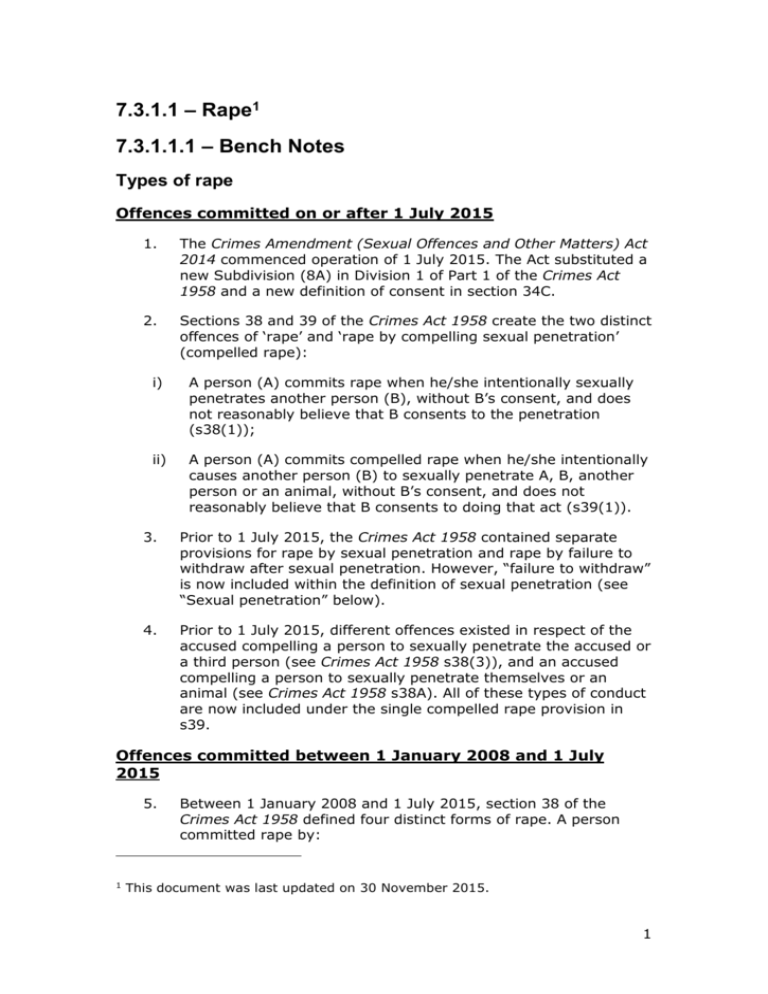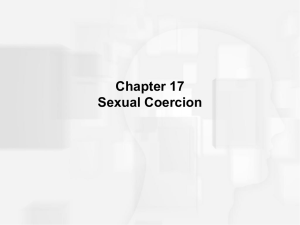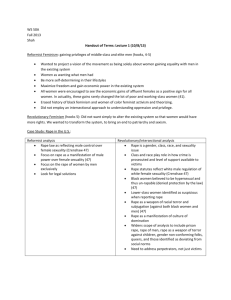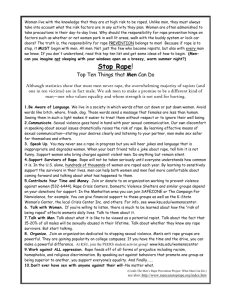
7.3.1.1 – Rape1
7.3.1.1.1 – Bench Notes
Types of rape
Offences committed on or after 1 July 2015
1.
The Crimes Amendment (Sexual Offences and Other Matters) Act
2014 commenced operation of 1 July 2015. The Act substituted a
new Subdivision (8A) in Division 1 of Part 1 of the Crimes Act
1958 and a new definition of consent in section 34C.
2.
Sections 38 and 39 of the Crimes Act 1958 create the two distinct
offences of ‘rape’ and ‘rape by compelling sexual penetration’
(compelled rape):
i)
A person (A) commits rape when he/she intentionally sexually
penetrates another person (B), without B’s consent, and does
not reasonably believe that B consents to the penetration
(s38(1));
ii)
A person (A) commits compelled rape when he/she intentionally
causes another person (B) to sexually penetrate A, B, another
person or an animal, without B’s consent, and does not
reasonably believe that B consents to doing that act (s39(1)).
3.
Prior to 1 July 2015, the Crimes Act 1958 contained separate
provisions for rape by sexual penetration and rape by failure to
withdraw after sexual penetration. However, “failure to withdraw”
is now included within the definition of sexual penetration (see
“Sexual penetration” below).
4.
Prior to 1 July 2015, different offences existed in respect of the
accused compelling a person to sexually penetrate the accused or
a third person (see Crimes Act 1958 s38(3)), and an accused
compelling a person to sexually penetrate themselves or an
animal (see Crimes Act 1958 s38A). All of these types of conduct
are now included under the single compelled rape provision in
s39.
Offences committed between 1 January 2008 and 1 July
2015
5.
1
Between 1 January 2008 and 1 July 2015, section 38 of the
Crimes Act 1958 defined four distinct forms of rape. A person
committed rape by:
This document was last updated on 30 November 2015.
1
i)
Intentionally sexually penetrating another person without their
consent, while being aware that the person is not or might not
be consenting, or while not giving any thought to whether the
person is not or might not be consenting (s38(2)(a));
ii)
After sexual penetration, failing to withdraw from a person who
is not consenting on becoming aware that the person is not
consenting or might not be consenting (s38(2)(b));
iii)
Compelling a person to sexually penetrate the offender or
another person (s38(3)(a)); and
iv)
Compelling a person who has sexually penetrated the offender
or another person not to withdraw (s38(3)(b)).
6.
This charge book includes charges for s38(2)(a) rape, and
s38(3)(a) compelled rape. If a case involves a failure to
withdraw, contrary to ss38(2)(b) and 38(3)(b), these charges will
need to be modified accordingly.
7.
Where the pleading confines the rape to the kind of rape which is
proscribed by s38(2)(a), and at no point during the trial is it
alleged that the accused had committed the kind of rape
proscribed by s38(2)(b), the judge should not direct the jury
about s38(2)(b) rape (R v SAB [2008] VSCA 150).
8.
Section 38(3) compelled rape is a wholly different offence to
s38A compelled sexual penetration. Section 38(3) applies where
the complainant is compelled to sexual penetrate the offender or
“another person” (i.e. a person other than the victim). Section
38A involves either compulsion of the victim to sexually
penetrate him or herself (i.e. self-penetration) or compelled
bestiality.
Rape and compelled rape
9.
As there have been no reported cases to date addressing the
requirements of compelled rape, these notes are primarily
concerned with rape simpliciter. It is assumed that most of the
principles will be equally applicable to compelled rape (with
appropriate modifications), and the charges relating to compelled
rape have been drafted accordingly.
Operation of rape provisions in the Crimes Act 1958
10. The offence of rape has changed significantly over time:
Date
Offence
Crimes Act
1958
Key changes
On/after 1
Rape;
s38; s39
New legislative definitions of
rape and compelled rape
2
Jul 2015
compelled rape
(including a new fault element
of no reasonable belief in
consent)
Crimes Amendment (Sexual
Offences and Other Matters)
Act 2014
1 Jan 2008
– 30 Jun
2015
Rape;
compelled rape
s38(2)(a);
s38(4)
Rape and compelled rape
definitions expanded
(introducing new fault element
based on non-advertence to the
complainant’s state of mind)
Crimes Amendment (Rape) Act
2007
1 Dec 2006
– 31 Dec
2007
Compelled rape
s38(3)
Compelled rape definition
modified (to make the offences
gender neutral)
Crimes (Sexual Offences) Act
2006
22 Nov
2000 – 30
Nov 2005
Compelled rape
1 Jan 1992
– 21 Nov
2000
Rape
5 Aug 1991
- 31 Dec
1991
Rape
1 Mar1981
– 4 Aug
1991
Rape
Pre 1 Mar
1981
Rape
s38(3)
First legislative definition of
compelled rape
Crimes (Amendment) Act 2000
s38(1)-(2)
New legislative definition of
rape
Crimes (Rape) Act 1991
s38
Rape definition modified
Crimes (Sexual Offences) Act
1991
s45
First legislative definition of
rape
Crimes (Sexual Offences) Act
1980
None
Common law
11. If an offence is alleged to have been committed between two
3
dates which straddle any of the commencement dates described
above, the allegation is to be treated as relating to the period
before the commencement of the new provision (Crimes (Rape)
Act 1991 s9(4); Crimes Act 1958 s593(4), s606A(2), s609(4)).
General guidelines
Offences committed on or after 1 July 2015
12. There are three elements of rape under s38(1). A person (A)
commits rape if:
i)
A intentionally sexually penetrates another person (B);
ii)
B does not consent to the penetration; and
iii)
A does not reasonably believe that B is consenting to the
penetration.
Offences committed before 1 July 2015
13. There were four elements of rape under s38(2)(a). A person
committed rape if he or she:
i)
Sexually penetrated another person;
ii)
Intentionally;
iii)
Without that person’s consent;
iv)
While being aware that the person was not consenting or might
not have been consenting or while not giving any thought to
whether the person was not consenting or might not have been
consenting.
All offences
14. It is preferable to use the language of the legislation in charging
the jury on the elements of rape (R v Soldo [2005] VSCA 136; R
v Zilm [2006] VSCA 72 per Callaway JA).
15. Judges should take care not to run the elements together. In
particular, judges should not instruct the jury that the final
element relates to “the guilty mind of the accused”. For example,
for offences committed before 1 July 2015, judges should not
instruct the jury that the prosecution must prove that the
accused “intended to commit the crime of rape in the sense that,
at the time of sexual penetration, he [or she] realized that the
complainant was not consenting or might not be consenting”.
This direction runs together the second and fourth elements (R v
Soldo [2005] VSCA 136; R v Zilm [2006] VSCA 72 per Callaway
JA).
4
16. A judge should not use the word “reckless” when directing the
jury about the accused’s knowledge as to lack of consent, as it is
not used in the statutory language and it may mislead the jury
because of its multiple legal meanings (R v Ev Costa 2/4/1997 CA
Vic).
“Sexual penetration”
Offences committed on or after 1 July 2015
17. “Sexual penetration” is defined by s37D of the Crimes Act 1958
for the offences in ss38-43 (including rape and compelled rape).
This definition is different from that in s35, which continues to
apply to all other sexual offences, and to rape or compelled rape
committed prior to 1 July 2015.
18. Section 37D provides that sexual penetration includes:
Penile penetration of the vagina, the anus or the mouth of
another person; and
Penetration by a part of the body (e.g. a finger) or by some
other object of the vagina or the anus, but not the mouth.
19. The definition of “sexual penetration” in s37D also includes the
act of continuing to keep a body part or object in the vagina or
anus once introduced, or the act of continuing to keep a penis in
the mouth once introduced (s37D(1)(d)-(f)). This removes the
need to distinguish between an act of sexual penetration and an
act of failure to withdraw after sexual penetration.
20. A person (A) also commits sexual penetration of another person
(B), if
A causes a third person to sexually penetrate B; or
A causes an act of penetration of B’s anus or vagina by the
penis of an animal (s37D(2)).
21. The definition of sexual penetration in s37D does not contain an
exception for good faith medical or hygienic procedures (compare
Crimes Act 1958 s35 prior to 1 July 2015). Instead, this
exception is built into the relevant offences, rather than the
definition of sexual penetration (ss38(3), 39(3)).
Offences committed before 1 July 2015
22. “Sexual penetration” was defined by s35 of the Crimes Act 1958
as
Penile penetration of the vagina, the anus or the mouth of
another person; and
5
Penetration by a part of the body (e.g. a finger) or by some
other object of the vagina or the anus, but not the mouth.
23. Conduct that would otherwise have fallen within the definition of
sexual penetration will not do so if carried out in good faith in
the course of a procedure for medical or hygienic purposes
(Crimes Act 1958, s35(1)). In such cases it is for the prosecution
to satisfy the jury that the accused did not subjectively believe
that there was a proper medical or hygienic purpose for carrying
out the act (R v Zaidi (1991) 57 A Crim R 189).
All offences
24. It is not sufficient for the relevant body part to have simply been
touched. It must have been penetrated to some extent
(Anderson v R [2010] VSCA 108).
25. Penetration need only be slight or fleeting. The definitions of
sexual penetration include the words “to any extent” (See Crimes
Act 1958 ss35 (before 1 July 2015) and 37D (on or after 1 July
2015). See also Randall v R (1991) 53 A Crim R 380; Anderson v
R [2010] VSCA 108).
26. The purpose of the penetration is irrelevant. It need not have
been committed for the purposes of sexual gratification (R v
Dunn 15/4/1992 CA NSW).
27. While in most cases the prosecution will be able to particularise
the method of penetration (e.g., the complainant was penetrated
by a penis), in some cases this will not be possible. In such
cases, it will be sufficient for the prosecution to particularise the
method of penetration by reference to the relevant possibilities
(e.g., the complainant was penetrated by a penis, a bodily part
or some other object) (R v Castles (Ruling No.1) [2007] VSC
561).
28. Where alternative possible methods of penetration are left to the
jury, they do not need to unanimously agree about which of
those methods was used. They only need to unanimously agree
that penetration took place (R v Castles (Ruling No.1) [2007]
VSC 561).
“Vagina”
All offences
29. The definition of vagina includes “the external genitalia”
(s35/s37C for offences committed before/on or after 1 July 2015,
respectively). It has been held that this phrase is not within
ordinary usage and needs more explanation. Where penetration
is in issue, the jury should have explained to them “in precise
and simple terms, what would constitute penetration of the outer
6
lips of the vagina, and to have summarised the evidence as it
related to that issue” (R v A J S [2005] VSCA 288. See also
Randall v R (1991) 53 A Crim R 380; Anderson v R [2010] VSCA
108; R v MG [2010] VSCA 97).
30. The definition of vagina also includes a surgically constructed
vagina (s35/s37C for offences committed before/on or after 1
July 2015, respectively). The offence can therefore apply to the
penetration of transsexual people.
“Consent”
All offences
31. “Consent” is defined in the Crimes Act 1958 to mean “free
agreement” (s36/s34C for offences committed before/on or after
1 July 2015, respectively). This definition of consent applies to all
of the provisions in Subdivisions 8A to 8D of the Crimes Act
(ss38-52).
32. This definition of consent is relevant both to whether the
complainant “consented” to the penetration, and to the accused’s
state of mind regarding whether the complainant was consenting
(the fault element).
33. The Crimes Act 1958 also provides a non-exhaustive list of
situations in which a person is regarded as not having given
consent. The listed situations in the earlier version (s36, for
offences committed before 1 July 2015) were similar, but slightly
narrower than those currently listed (s34C, for offences
committed on or after 1 July 2015).
34. Neither previous s36 nor s34C are expressly drafted as “deeming
provisions”, but it is relatively clear that they must be treated
this way. This interpretation is supported for trials commenced
on or after 1 January 2008 by either s37AAA(b) and (c) for
offences committed before 1 July 2015 and by Jury Directions Act
2015 s46(4)(b) for offences committed on or after 1 July 2015
(see also R v Getachew (2012) 248 CLR 22 at [19]).
35. For a full discussion of this topic see Bench Notes: Consent and
Awareness of Non-Consent (pre 1 July 2015) and Bench Notes:
Consent and reasonable belief in consent (1 July 2015 onwards).
For the full text of these provisions as amended at different
points in time see [7.3.A – Legislation – Sexual Offences General
Provisions].
7
Fault element: the accused’s awareness of, or belief in,
consent
Offences committed on or after 1 July 2015
Warning! This element has not yet been considered by the Court of
Appeal. The following material is provided as a guide only and must be
used with caution.
36. The third element is that the accused “does not reasonably
believe that [the complainant] consents to the penetration”
(Crimes Act 1958, s38(1)(c)).
37. This fault element will be satisfied by any one of the following
mental states:
i)
The accused believed that the complainant was not consenting;
ii)
The accused did not believe the complainant was consenting.
This includes circumstances where the accused gave no thought
as to whether the complainant was consenting;
iii)
The accused believed the complainant was consenting, but
his/her belief was not reasonable in the circumstances.
38. This element introduces objectivity into the fault element for rape
and rape related offences (Crimes Amendment (Sexual Offences and
Other Matters) Bill 2014 Explanatory Memo).
39. This element is explained in more detail in Bench Notes: Consent and
reasonable belief in consent (1 July 2015 onwards).
Offences committed between 1 January 2008 and 1 July
2015
40. For offences committed between 1 January 2008 and 1 July
2015, the fault element consists of proof that the accused had
any one of the following three different mental states:
i)
An awareness that the complainant was not consenting
(s38(2)(a)(i)), s38(4)(b)(i);
ii)
An awareness that the complainant might not be consenting
(s38(2)(a)(i)), s38(4)(b)(i);
iii)
A failure to give any thought to whether or not the complainant
was consenting (s38(2)(a)(ii), s38(4)(b)(ii)).
Awareness of the real possibility of non-consent
41. The word "might" in the phrase “might not be consenting”
suggests a test based on the “possibility” of non-consent. It does
not suggest that the accused must have been aware that it was
8
“probable” that the complainant was not consenting. However,
the possibility of non-consent must be real, not just theoretical
(R v Ev Costa 2/4/1997 CA Vic).
Non-advertence
42. For offences committed after 1 January 2008 it is no defence for
the accused to assert that he or she was not aware that the
complainant might not have been consenting to the sexual act
because the accused had not given any thought to whether or
not the complainant was consenting (Crimes Act 1958
s38(2)(a)(ii), s38(4)(b)(ii)).
43. Prior to this amendment it was uncertain whether or not “nonadvertence” provided a defence. On one view, non-advertence
was a culpable state under the common law, and this continued
for the statutory offence of rape – see DPP v Morgan [1976] AC
182 and R v Tolmie (1995) 37 NSWLR 660. However, the Crimes
Amendment (Rape) Bill 2007 was enacted on the basis that this
mental state was not previously culpable (see Attorney-General
Rob Hulls, Second Reading Speech, Crimes Amendment (Rape)
Bill 2007). The charge-book charges reflect this view. If nonadvertence was a culpable mental state prior to the amendment,
and it is an issue in a pre-amendment case, the charge will need
to be modified.
Effect of intoxication on awareness
44. Intoxication can also be relevant to the issue of mistaken belief in
consent. See Bench Notes: Common Law Intoxication for more
information.
Jury directions on awareness of or belief in consent
45. Sections 37 and 37AA of the Crimes Act 1958 provide a
framework of directions in respect of the accused’s awareness of
the complainant’s state of consent. These directions are
mandatory where relevant to the facts in issue in a proceeding
(Crimes Act 1958 s37(1)).
46. For a full discussion of this topic see Bench Notes: Consent and
Awareness of Non-Consent (pre 1 July 2015). For the full text of
these provisions as amended at different points in time see
[7.3.A – Legislation – Sexual Offences General Provisions].
Compelled rape
Offences committed on or after 1 July 2015
47. “Rape by compelling sexual penetration” is a separate offence
contained in s39.
9
48. The elements of compelled rape are as follows (s39(1)):
An accused person commits compelled rape if s/he:
i. Intentionally causes another person to sexually penetrate —
the accused; or
themselves, or
a third person, or
an animal; and
ii. The person doing the penetrating does not consent to doing
the act of sexual penetration; and
iii. The accused does not reasonably believe that that person
consents to doing that act.
49. The elements of the offence are similar to those of rape, but
rather than the accused intentionally sexually penetrating the
complainant, the accused intentionally causes the complainant to
sexually penetrate either the accused, him/herself, a third person
or an animal (s39(1)(a)).
50. The definition of sexual penetration includes the following:
i. A person sexually penetrates themselves if they introduce a part
of their own body or an object into their anus or vagina, or having
so introduced such body part or object, continues to keep it there
(s37D(3)).
ii. A person sexually penetrates an animal if they introduce a part of
their own body or an object into the animal’s anus or vagina, or
their penis into the animal’s mouth, or having so introduced such
body part or object, continues to keep it there (s37D(4)).
51. While the accused must intentionally cause the penetration,
compulsion is not a separate element. Compulsion is shown
through the elements of lack of consent by the person doing the
penetration, and lack of a reasonable belief by the accused in
that consent, as in the offence of rape (s39(1)).
52. The accused will have committed the offence of compelled rape in
relation to the person s/he causes to do the penetrating, not the
person penetrated. Where the accused causes the complainant to
penetrate a third person, the accused will have committed rape
simpliciter of that third person, assuming the other elements are
met (s37D(2)).
53. For the purposes of compelled rape, it is the consent of the
complainant, that is the person doing the sexual penetration, and
10
the accused’s belief in that person’s consent, that is relevant.
Offences committed before 1 July 2015
54. The compelled rape offences, like rape, involve sexual
penetration without consent. For offences committed before 1
July 2015, the physical roles of offender and victim are reversed,
and the compelled rape offence adds the additional concept of
“compulsion” (see Crimes Act 1958 s38(3)).
55. Compulsion is defined in s38(4) as follows:
(4)
For the purposes of subsection (3), a person compels
another person (the victim) to engage in a sexual act if the
person compels the victim (by force or otherwise) to
engage in that act—
(a) without the victim's consent; and
(b) while—
(i)
being aware that the victim is not consenting or might
not be consenting; or
(ii) not giving any thought to whether the victim is not
consenting or might not be consenting.
56. This definition is mirrored for the separate offence of compelling
sexual penetration contrary to s38A (Crimes Act 1958 s38A(3)).
11








